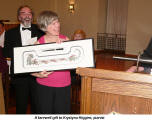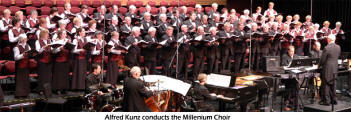
Canadian Rhapsody
– A Tribute to Canada –
Sybille Forster-Rentmeister
 How
proud Canadians are of their Canada was very apparent on May 25th,
2006, in The Centre of the Square, Kitchener. A concert, which had been in
the planning for nearly 2 years, finally came to fruition and featured 2
very special musical commissions for Alfred Kunz, the first of which
followed a spirited introduction of Irish and Afro-American songs performed
by the Millennium Choir, with the Concordia Male Chorus making a guest
appearance, and crowd-pleasing Ukrainian dances.
How
proud Canadians are of their Canada was very apparent on May 25th,
2006, in The Centre of the Square, Kitchener. A concert, which had been in
the planning for nearly 2 years, finally came to fruition and featured 2
very special musical commissions for Alfred Kunz, the first of which
followed a spirited introduction of Irish and Afro-American songs performed
by the Millennium Choir, with the Concordia Male Chorus making a guest
appearance, and crowd-pleasing Ukrainian dances.
The highlight of the first part of the evening followed, a commission from the Tuerr Family about Anne Tuerr’s life, starting with happy beginnings 1927 in the region of Banat, Yugoslavia, a 200 year old settlement of the Danube Swabians. In 1944 Anne was taken, as were many of her country folks, in cattle cars to the Ukraine, where she suffered unspeakable hardships, yet somehow managed to survive with the help of her faith. After 3 years of hard labour under catastrophic living conditions she was sent to Frankfurt an der Oder and then to Vienna, where she managed to reunite with some of her family, the part that had not perished in the war.
Shortly thereafter, through much more hardship she arrived in Canada, where she met her husband Paul Tuerr. They married after all financial obligations had been cleared away and enjoyed a long and happy marriage with several children until Anne’s death in 2005.
 This is the life on which the dramatic choral composition by
Alfred Kunz is based on, in memoriam. The different stations of Anne’s life
are clearly audible and thus visible to the inner eye of the listener. Mr.
Kunz managed to communicate all of the joys and sorrows of this life of Anne
Tuerr, that reminds us that freedom is not something to be taken for
granted; instead it needs to be nurtured and if need be defended.
This is the life on which the dramatic choral composition by
Alfred Kunz is based on, in memoriam. The different stations of Anne’s life
are clearly audible and thus visible to the inner eye of the listener. Mr.
Kunz managed to communicate all of the joys and sorrows of this life of Anne
Tuerr, that reminds us that freedom is not something to be taken for
granted; instead it needs to be nurtured and if need be defended.
Anne’s philosophy put into very simple words is valid no matter who is concerned, here or anywhere else in the world: "We should never forget our dead, but for the sake of our children we must forget and get on with our lives to build a better world, a world without hate, a world with peace." This theme as the leitmotif threads through the entire composition repetitively, less we forget its importance.
The Musicians
Drawing on classical examples of dramatic choral works Mr. Kunz managed to give this work a unique and Canadian flavour that transcends time effortlessly by including more avant-garde harmonies, slightly reminiscent of Orff’s works at some point, which adds tremendous drama to the story telling, actually underlining the importance of those passages.
The composition was very well received and left a deep impression on the audience.
After this moving performance it was most fitting to hear the Youth and Children’s Millenium division sing and play something really Canadian. Musical reflections of Hockey, Eskimo Lullaby, Spirit of the Sun, Do not weep, and Donkey Riding delighted everyone.
Soloists of the Choirs
 This was followed by a Scottish segment, featuring tenor
soloist Peter McCutcheon, a student of popular tenor Mark DuBois. Of several
selections the traditional Scots wha ha’e… was a favourite. No
wonder, it deals with what we all crave most: Liberty! However, the very
rousing We rise again also drew huge enthusiasm, likely because that
is a Canadian theme so strong, it was the reason why most people came here.
This was followed by a Scottish segment, featuring tenor
soloist Peter McCutcheon, a student of popular tenor Mark DuBois. Of several
selections the traditional Scots wha ha’e… was a favourite. No
wonder, it deals with what we all crave most: Liberty! However, the very
rousing We rise again also drew huge enthusiasm, likely because that
is a Canadian theme so strong, it was the reason why most people came here.
After an intermission we heard another commissioned work and it was all about Canada. The evening’s narrator was none other then Michael W. Higgins, who is leaving with his wife Krystyna, the participating choirs’ accompanist, to head up a University in Fredericton. He had asked Alfred Kunz, artistic director of this fantastic evening, to compose Canadian Portraits, of which there are three: Emily Carr a painter identified with painting our countries very soul.
William Kurelek, prairie painter and illustrator of Ukrainian decent, who painted quaint and sometimes disturbing images of all our heritages.
Bejamin Chee Chee, native Canadian artist extraordinaire! His Canada geese reflect the spirituality natural to our First Nation People.
 Alfred Kunz took the essence of these special individuals
and defined the characteristics in music and indeed left us with a spiritual
experience. No wonder this work is called a choral painting.
Alfred Kunz took the essence of these special individuals
and defined the characteristics in music and indeed left us with a spiritual
experience. No wonder this work is called a choral painting.
This would have been a good time to end the concert, but
when so much work goes into a project so much wants to be said and shown and
shared.
 Thus we saw the Ukrainian dancers again, heard some more Canadian
sounds, like Gordon Lightfoot’s Did she mention my name?- of course
with a Kunz arrangement - like most of the evenings works. A French
maritime piece was not missing to complete a multicultural voyage across the
history of our lives and our nation.
Thus we saw the Ukrainian dancers again, heard some more Canadian
sounds, like Gordon Lightfoot’s Did she mention my name?- of course
with a Kunz arrangement - like most of the evenings works. A French
maritime piece was not missing to complete a multicultural voyage across the
history of our lives and our nation.
 The finale was nothing short of spectacular with the flags
of all provinces and territories being carried onto the stage and all
performers, all 275 of them, and a standing audience singing O Canada
from the very bottom of their hearts. Indeed, this was a Canadian Rhapsody.
The finale was nothing short of spectacular with the flags
of all provinces and territories being carried onto the stage and all
performers, all 275 of them, and a standing audience singing O Canada
from the very bottom of their hearts. Indeed, this was a Canadian Rhapsody.
 The evening concluded for a lot of the singers in the
Concordia Club. The big hall was filled to capacity and Paul Tuerr was on
hand with his family to celebrate
The evening concluded for a lot of the singers in the
Concordia Club. The big hall was filled to capacity and Paul Tuerr was on
hand with his family to celebrate
 the first performance of his commissioned
work. Alfred Kunz honoured Paul Tuerr with a memento for this occasion, a
collage of writings and a page of the musical score.
the first performance of his commissioned
work. Alfred Kunz honoured Paul Tuerr with a memento for this occasion, a
collage of writings and a page of the musical score.
 The Higgins’ were given a fond farewell with a gift of
paintings and Dana Kunz surprised her husband also with a painting.
The Higgins’ were given a fond farewell with a gift of
paintings and Dana Kunz surprised her husband also with a painting.
 At
midnight the mood was still intimate and high and happiness prevailed,
hopefully to last us through some of the darker days. Music will always help
us to that. Thus we thank the
At
midnight the mood was still intimate and high and happiness prevailed,
hopefully to last us through some of the darker days. Music will always help
us to that. Thus we thank the
 commissioner of art and musical works, the
composers and the re-creators - the choirs and soloists, the musicians that
make up an orchestra, the dancers and all other artists who brighten our
days. Without them life is hardly worth remembering!
commissioner of art and musical works, the
composers and the re-creators - the choirs and soloists, the musicians that
make up an orchestra, the dancers and all other artists who brighten our
days. Without them life is hardly worth remembering!















